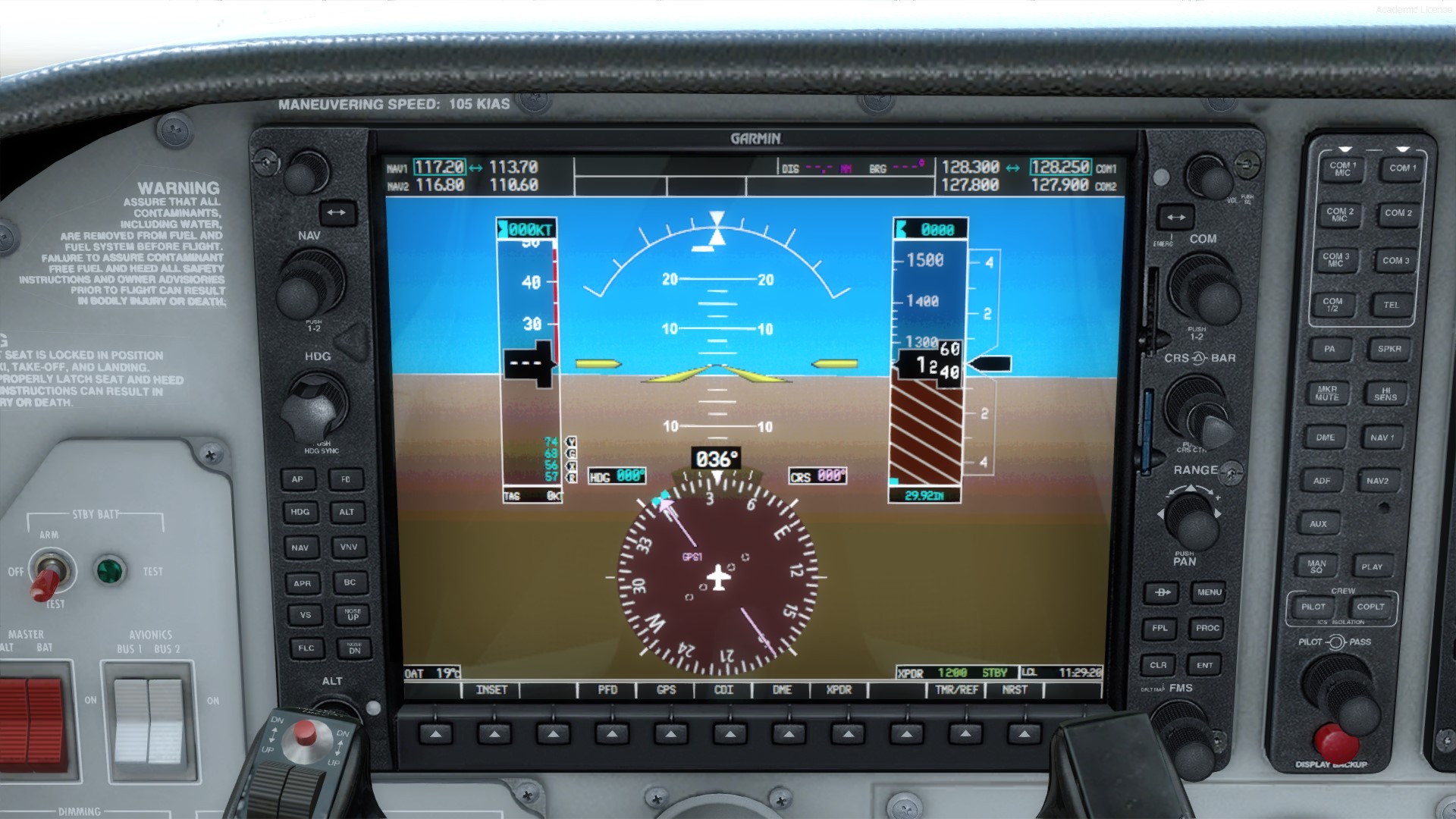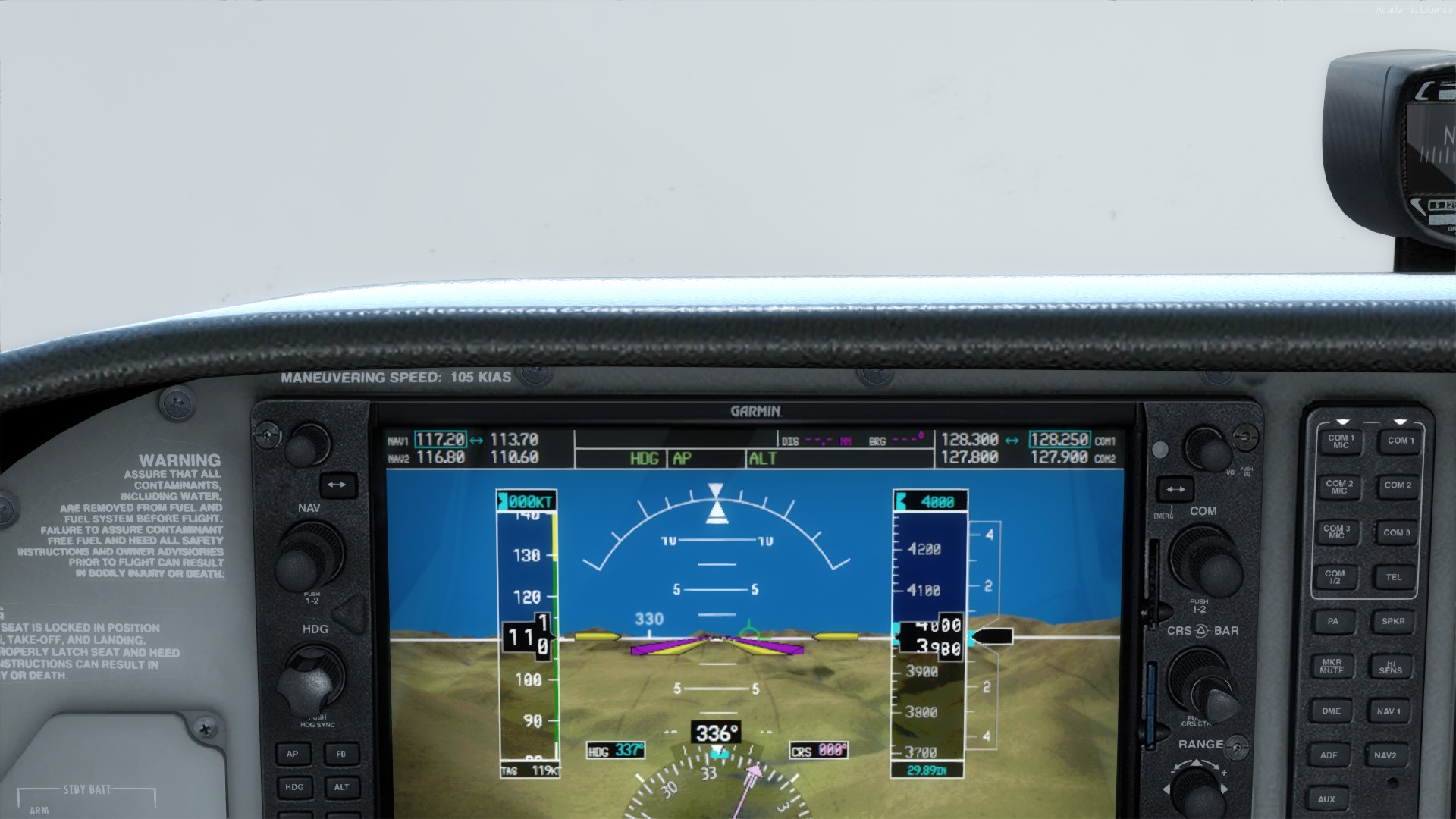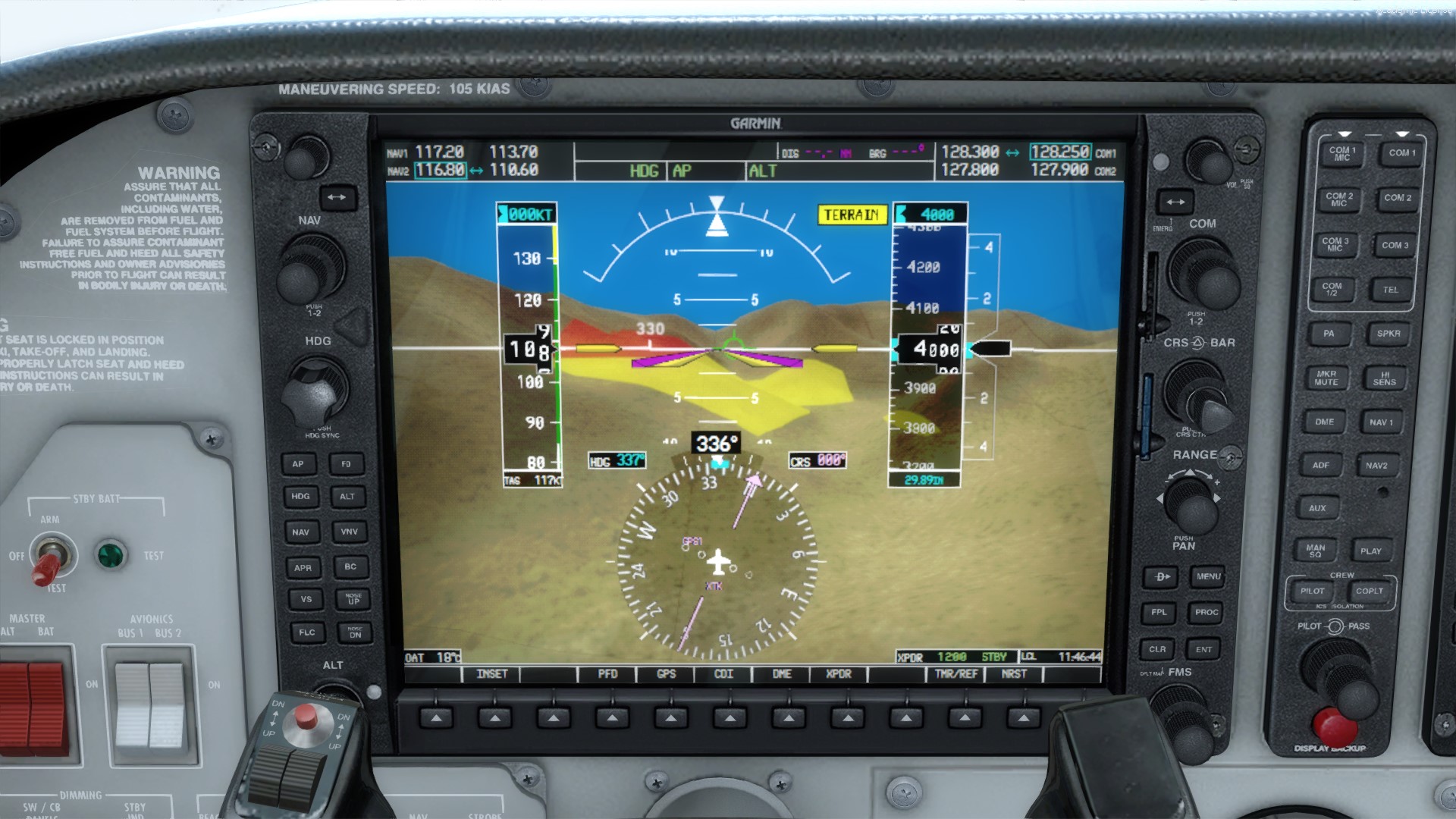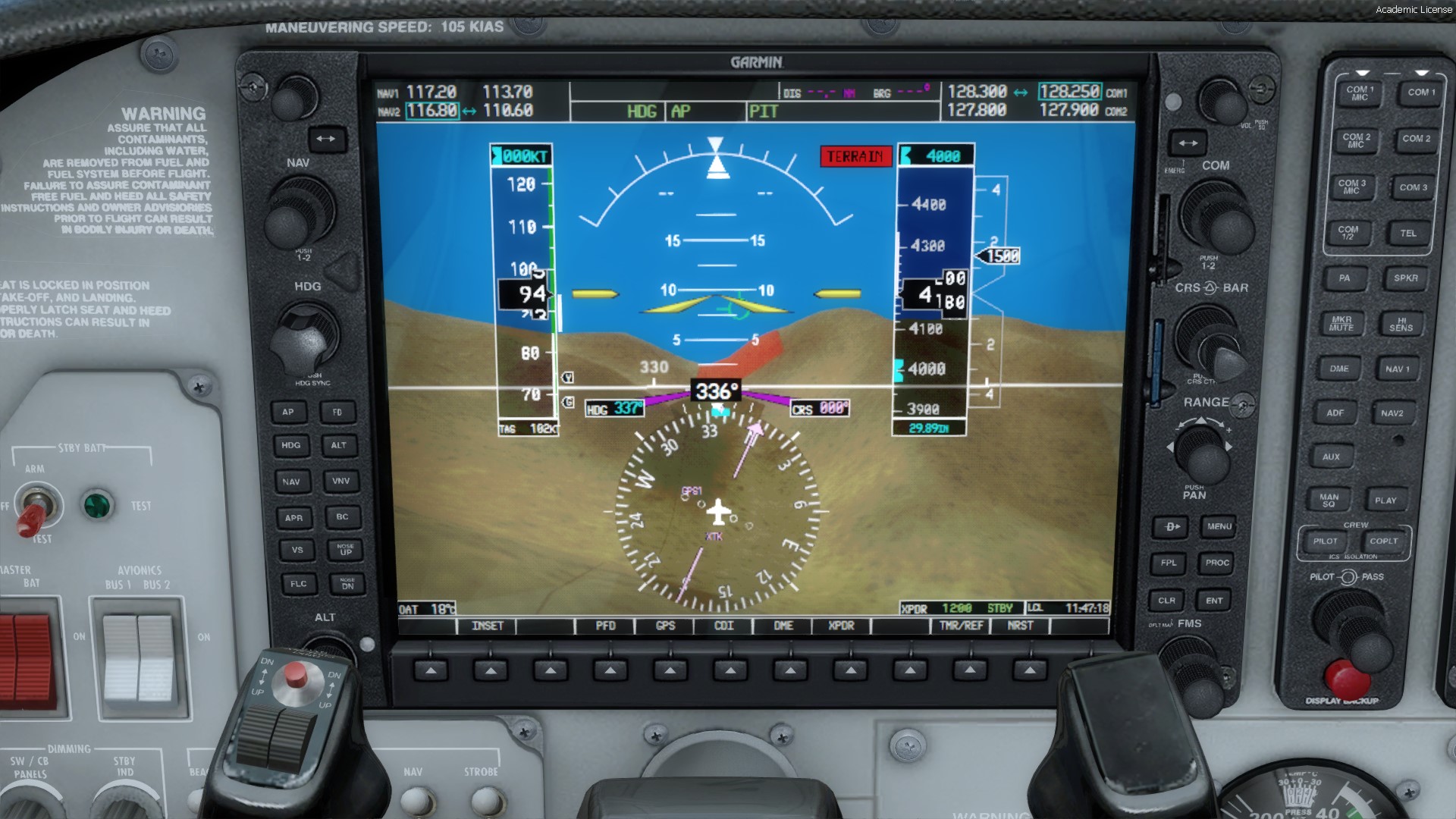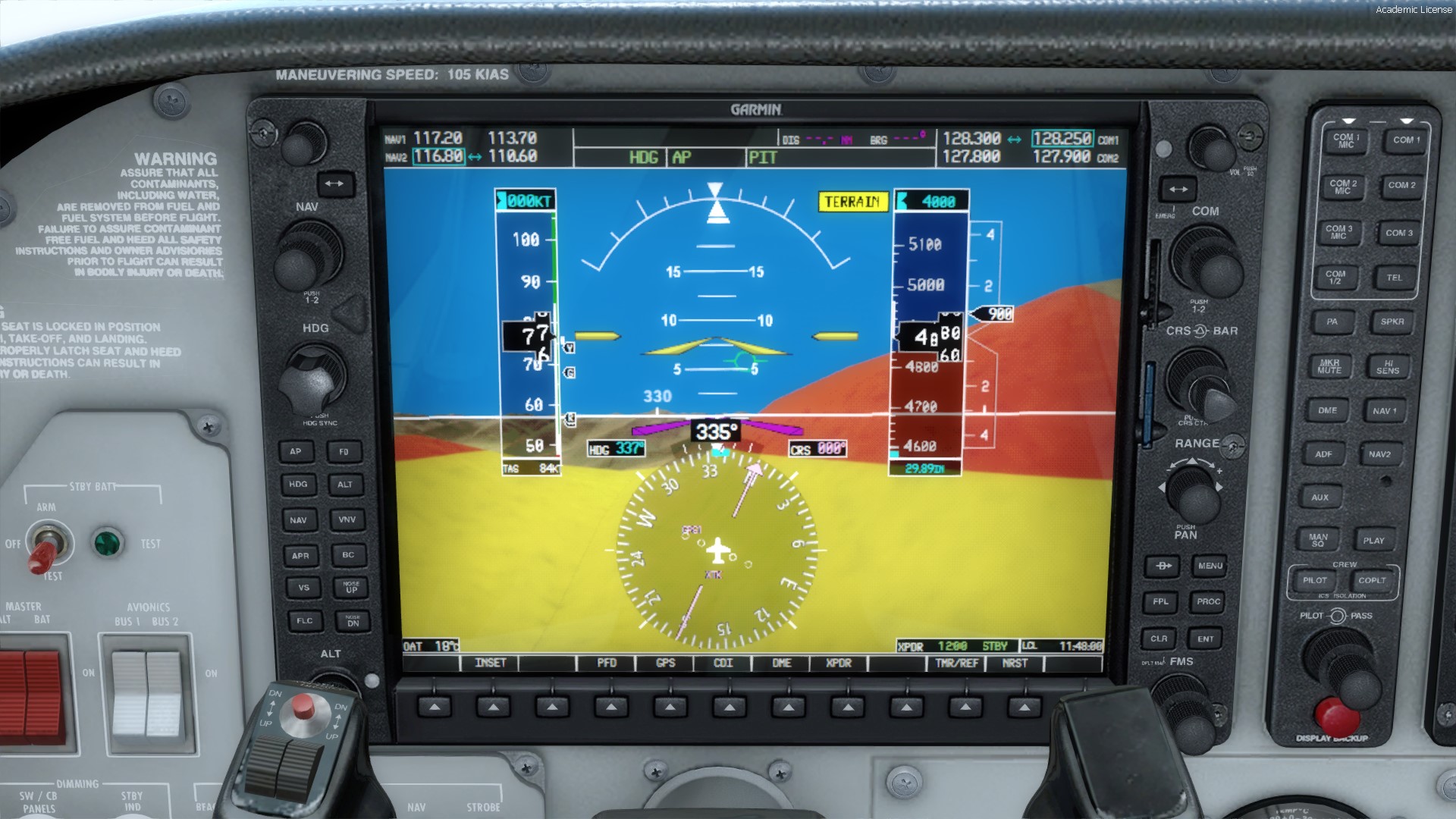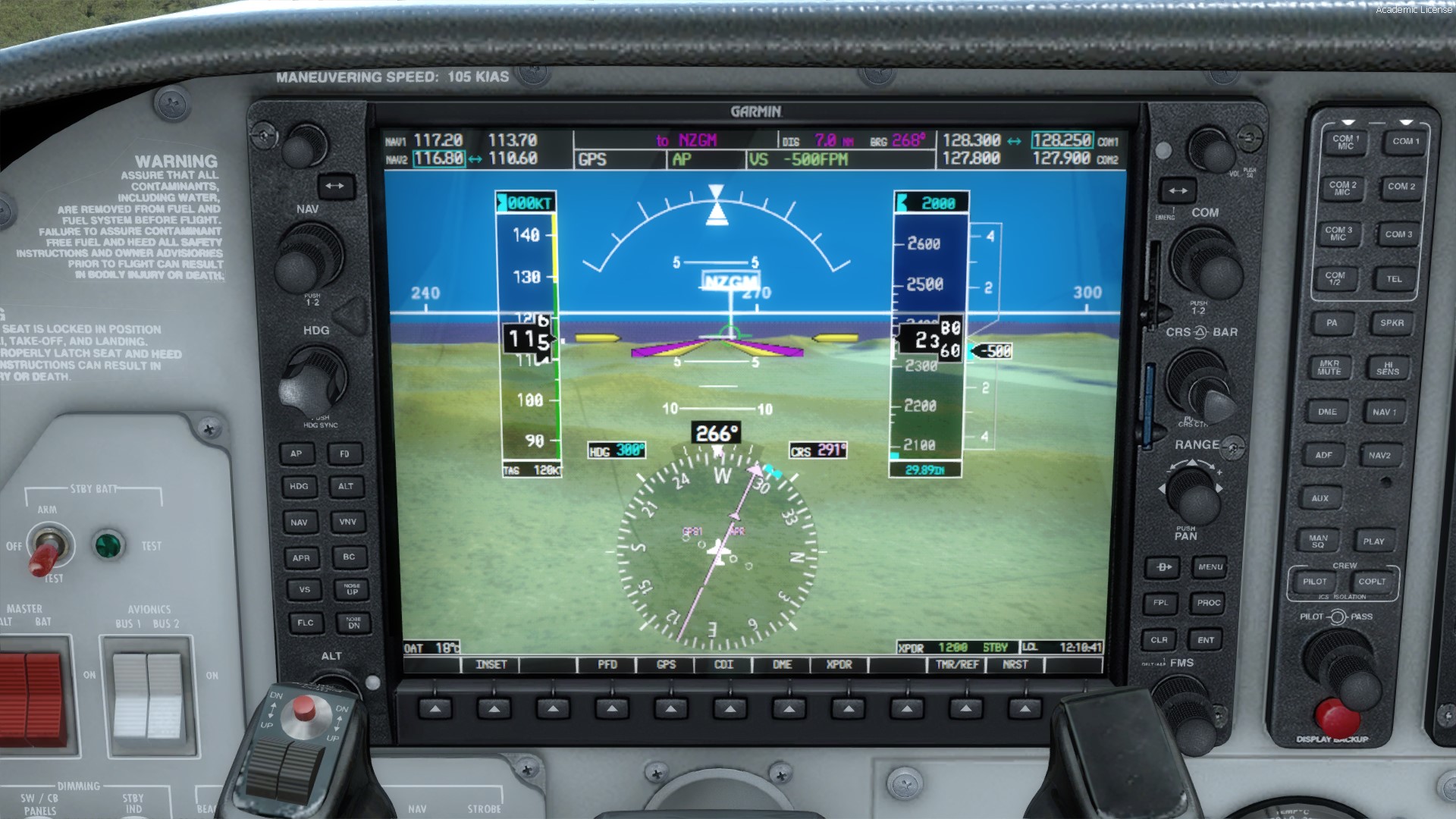Introduction
When glass cockpits were first introduced, they brought with them a new dimension to flying and aircraft and cockpit management. Like any technology, it has continued to develop at a fast pace with additional functionality being incorporated and more advanced glass cockpit suites available. This functionality now goes way beyond just being a replacement for the old analogue primary flight instruments and engine management instruments. A more recent innovation to improve cockpit situational awareness has been the introduction of Synthetic Vision Systems.
Now, every once in a while, a developer will bring out an interesting utility to enhance the flight simulator experience. Carenado have done just that in releasing the Synthetic Vision System (SVS) to complement their range of aircraft with a Garmin G1000 class cockpit. Well renowned for their excellent range of add-on aircraft, Carenado's SVS takes piloting aircraft with a Garmin G1000 glass cockpit to a new dimension.
History
Developed by NASA and the United States Air Force in the later part of the 20th Century, the SVS was seen as a means by which to improve cockpit situational awareness using three dimensional images to provide pilots with a clear and intuitive means of understanding their flying environment. An SVS provides situational awareness to the pilot by using terrain, obstacle, geopolitical, hydrological and other databases from a set of databases stored on board the aircraft, an image generator computer, and a display. The navigation solution is obtained through the use of GPS and inertial reference systems. The projected path of the aircraft, in perspective view, is depicted using "Highway In The Sky". This provides the pilot with an instantaneous understanding of the current, as well as the future, state of the aircraft with respect to the terrain, towers, buildings and other environment features.
NASA initiated industry involvement with major avionics manufacturers in early 2000 and the first FAA certified application of a synthetic vision system occurred in 2009. Since then, many newer glass cockpit systems, such as the Garmin G1000, and the Rockwell Collins Pro Line Fusion, offer synthetic terrain. In 2017, Avidyne Corporation certified Synthetic Vision capability for all of its IFD Series GPS based Flight Management Systems. However, in an ironic historical note, recreational uses of synthetic vision with Bruce Artwick's original FS1 Flight Simulator preceded its application in aircraft.
Availability and Installation
The Carenado Synthetic Vision System is currently available direct from Carenado and Carenado resellers as a download only product (some resellers also offer a master back-up CD / DVD service for a minor additional cost). It is normally priced at US$29.95, or the equivalent on currency cross rates. The download file size is 78MB and it requires 100MB of HDD / SSD space for installation. An activation key is issued on purchase and is used during installation and the installation process is intuitive and seamless.
Once installed, a "first run" of the SVS is required to enable it for the respective aircraft. The manual details this and some important information regarding firewalls and anti-virus exceptions. These are important to ensure the product runs correctly.
provides a three year licence to access the WebSimConnect SVS Cloud service providing a nine arc-second SVS database of the terrain for the entire planet;
the product does not work alone;
also needs any Carenado aircraft equipped with a G1000 glass cockpit;
only need to buy this product once to use it with any Carenado aircraft equipped with a G1000 glass cockpit; and
other aircraft purchased prior to the release of the SVS (17 November 2017), will need to be downloaded again and reinstalled.
As an alternative, if you purchase Carenado's Cessna 172SP Skyhawk G1000 product, this provides a one year licence to access the WebSimConnect SVS Cloud service providing a nine arc-second SVS database of the terrain for the entire planet. This will also enable the SVS for other Carenado G1000 equipped aircraft under the one year licence.
Features
The following are the major features of the SVS:
synthetic view of the terrain with height as a colour map (consistent with those of the topographical MFD map display);terrain TAWS/B alerting;
ground "noise" textures on the terrain;
major water bodies (large lakes, reservoirs and rivers);
flight path marker;
horizon heading marks;
airport signs;
runway display with updatable database;
outlined selected approach runway; and
quality / performance configuration tool.
Aircraft Compatibility
The following current Carenado aircraft are compatible with the Carenado SVS:
Cessna 172SP Skyhawk G1000;Cessna T182T Skylane G1000;
Cessna T206H Stationair G1000 Extension Pack;
Cessna 208B Grand Caravan EX;
Cirrus SR22 GTSx;
Embraer E50P Phenom 100;
Embraer EMB505 Phenom 300;
Piper PA-46 500TP Malibu Meridian G1000; and
Socata TBM 850.
A Smack to the Face with "4 by 2"
The Sceptic. Let's start with an admission! I generally do not find add-on utilities terribly exciting or beneficial, to the point of finding some of them to be very twee. For my flight simming requirements, I often find such products to consist of a sweet sugary coating and sometimes lacking in any real substance. When I initially saw the release of the SVS, packaged with the Cessna 172SP G1000 product, my first impression was, "looking forward to the aircraft, but I don't care too much for the SVS.". Now, this is coming from someone who owns all the Carenado G1000 equipped aircraft and uses them both regularly and extensively in all manner of flying situations. Well, how wrong could I be, and even about my own flight simming requirements. This is one of the beauties about such a product, it grows on you. No, in fact, the SVS did not just grow on me, it smacked me right between the eyes with a solid piece of "4 by 2"!
The Scenario. My first opportunity to test the SVS occurred on my weekly Sunday night fly-in, a multiplayer session with an insane bunch of reprobates (Mutley's Hangar Crew). At the time, we were flying a route traversing the south island of New Zealand using real world weather, and the conditions were atrocious. Talk about the "Land of the Long White Cloud", this cloud was continuous and "very solid". Believe me when I tell you that this is an intrepid bunch of flyers, slightly procedural, "Did you check gear up?", "What gear?", "Your landing gear!", "It's fixed.", "Oh, I didn't know it was broken.", seat of your pants, flying circus. We were flying small GA aircraft and it was a perfect scenario to test the Carenado SVS.
The Eye Opener. I chose the Carenado Cessna T182T Skylane. We were flying out of a small "farm strip" and after activating all the SVS functionality and displays on the Garmin G1000 PFD, the three dimensional world comes to life in the cockpit. The first and most obvious thing was the SVS displayed how the runway sloped left to right in front of me. This took some getting used to and added a new dimension to "trusting your instruments". Beyond this the three dimensional image of the mountains was, to say the least, impressive. This was going to be interesting as the first flight leg required an immediate climb to about 8,000 feet to clear the mountains, but at 2,000 feet you passed into the cloud layer. OK, so not exactly procedural flying, but who cares, we certainly didn't, that's why we do it. This is when I first realised the power of the SVS. Looking out the cockpit window, I couldn't see past the wing tip, back to the PFD and the three dimensional world, with mountain ridges and detailed valleys, was presented for me to just pick my course through the mountains. In the meantime, my fellow reprobates are screaming over the session voice call trying to pick their route through the "solid clouds". Enough said, I was sold!
Functionality
What the SVS Does Not Simulate. Disclaimer alert for the puritans who need it! Compared to the real world system, the following SVS enhancements are not implemented on the Carenado SVS:
pathways,
traffic display, and
obstacle alerting.
What is the SVS. The SVS depicts a forward looking attitude display of the topography immediately in front of the aircraft. The SVS information is shown on the PFD with a field of view 30 degrees to the left and 35 degrees to the right. The depicted imagery is derived from the aircraft attitude, heading, GPS three dimensional position, and a nine arc-second database of terrain, and other relevant features. The terrain data resolution of nine arc-seconds, meaning that the terrain elevation contours are stored in squares measuring nine arc-seconds on each side, is required for the operation of SVS and it covers the entire planet. Access to this terrain data is provided by the three year licence to access the WebSimConnect SVS Cloud service.
Ease of Use
What else can I say but, simplicity personified! Once you have completed the initial setup, it is as simple as pressing buttons. The manual covers far more detail than I have covered here and the sections on Quality and Performance Configuration, Runways Database, and Troubleshooting are MUST READS to ensure you are getting the most out of the SVS for your flight simulator hardware and software setup. The aspects regarding firewalls and anti-virus exceptions will require you to be familiar with these on your particular computer, so be warned.
Issues and Variations
The Carenado SVS cannot be simpler and it is an excellent representation of the real world systems. My terrain mesh is the FS Global Ultimate region series and I was impressed with how the terrain compared with the three dimensional representation provided by the SVS. Any noted variations were minor, with functionality variations being a factor of the limitations within the flight simulator or some artistic licence on the part of the developer. These variations are explained in the manual. Some of these variations are in the interests of modifying the functions for practical flight simulator use.
Documentation
A 15 page manual is provided in Adobe Acrobat format (.pdf) for the SVS and includes comprehensive details on all relevant sections.
Value for Money
The Carenado SVS is far more dependent on the individual flight simmer's specific type of flying. By this I mean that you need to do regular flying using a Carenado aircraft equipped with G1000 glass cockpits. As the price is based on a three year licence model, you need to assess your projected usage of the product over that time period. If you do a lot of your regular flying using a Carenado aircraft equipped with G1000 glass cockpits, or indeed, multiple such aircraft, then the Value for Money proposition for the Carenado SVS is excellent, noting the three year licence limitation. If your regular flying does not fit this profile, then this product is not for you.
Simulator Performance
The Carenado SVS performed excellently within the existing settings I have in P3D. I have most of my settings set very high and there was no need to make any adjustments. There was no discernible frame rate impact directly attributable to the Carenado SVS and P3D continued to perform smoothly. Important Note. Using the Quality and Performance Configuration Tool is essential to getting the optimum setup for your computer system.
Technical Requirements
This version of the Carenado Synthetic Vision System is for FSX/FSX SE/P3D only. Other specified technical requirements are as follows:
Windows 10/8/7, 64bit only;FSX with SP2 installed (or Acceleration Pack), FSX Steam Edition, or P3D (v2/v3/v4); and
Important Note. The Carenado SVS requires a dedicated GPU graphics card supporting at least WebGL1 specification. On some older graphics cards (4 - 5 years old) the SVS might not function properly.
Review Computer Specifications
The specifications of the computer on which the review was conducted are as follows:
Intel i7 990X Extreme 3.46GHz;
NVidia GTX980 G1 Gaming, 4GB, 1228/1329MHz;
12GB, Kingston DDR3, 2000MHz, XMP T1 CL9 HyperX;
Windows 7, (64bit); and
Lockheed Martin Prepar3D v4.
Additional Major Add-ons. Active Sky for P3Dv4, Active Sky Cloud Art, FS Global Ultimate region series, Orbx FTX Global BASE, Orbx FTX Global VECTOR, Orbx FTX Global openLC series, Orbx FTX Trees HD, Orbx FTX region series, and Orbx FTX airport series.
Conclusion
Carenado have produced an excellent utility in the SVS. For those who regularly fly using Carenado G1000 equipped aircraft, this is an add-on which will significantly enhance the immersion factor of your flight simming. Its functionality provides an excellent representation of the real world systems, with noted exceptions due to limitations within the flight simulator, with additional functionality also provided as noted. With its multiple application across all Carenado G1000 equipped aircraft, and if you do a lot of your regular flying using any / all of these aircraft, then the Carenado SVS is worth serious consideration.
Verdict and Scores
Verdict
| A fantastic enhancement to G1000 glass cockpit functionality, the Carenado Synthetic Vision System is an excellent add-on. |
Scores
For |
Against |
Category |
Score/10 |
|---|---|---|---|
| Excellent features. | Three year licence. | Features | 9.5 |
| Easy to use. | Need to be a regular user. | Ease of Use | 10 |
| Excellent performance. | Performance | 10 | |
| Thorough documentation. | Documentation | 10 | |
| Value for Money | 9.0 |
Overall Score

The Carenado Synthetic Vision System is awarded an overall Mutley's Hangar score of 9.7/10, |


